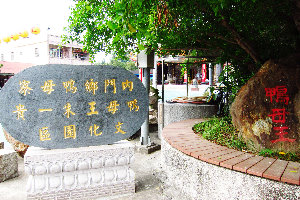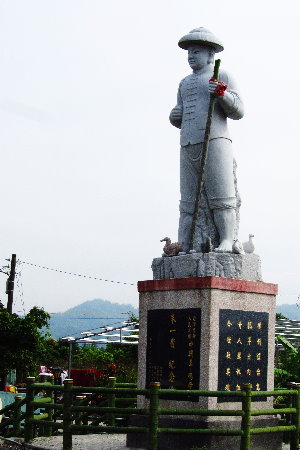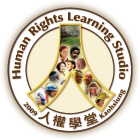  Kaohsiung Human Rights Travel Guide Kaohsiung Human Rights Travel Guide |
 |
| |
 朱一貴文化園區(Chu Yi-kuei Culture Park) 朱一貴文化園區(Chu Yi-kuei Culture Park) |
   |
| |
人稱鴨母王是高雄內門區有著傳奇的人物,也是台灣規模最大的反清活動領導人物,但起義不久後就被內地前來支援的清軍所撲滅。鄉民以「天上聖母」的名義,在起義地旁建造了一座「鴨母王祠」,取名「興安宮」,同時祀奉媽祖與朱一貴。 「朱一貴文化園區」由二座雕像與池塘、養鴨寮、石雕群圍牆構成,包括「興安宮」對面為了重現當年朱一貴養鴨池情景的池塘,池塘中央有朱一貴雕像,正面寫著「台灣皇帝,人民英雄,中興王.鴨母王」的題字。另有一尊由群鴨環繞的較小的舊石雕像,展現傳說中朱一貴以竹竿指揮鴨群的姿態,兩者共同成為現在內門地區最重要的歷史文化景點。
|
Known as the “Duck King,” Chu Yi-kuei was a legendary figure from the Neimen District of Kaohsiung City, and a leader of the largest anti-Manchu uprising in Taiwan. However, shortly after the uprising started, he was captured and executed by Imperial forces from the mainland. Using the name of the god Matsu, villagers built a temple next to the site of the uprising to commemorate the “Duck King.” The temple is known as the Sing-An Temple, and enshrines both Matsu and Chu Yi-kuei. The “Chu Yi-kuei Culture Park” consists of two statues, a pond, a flock of ducks, and a carved stone wall. Opposite the Sing-An Temple, there is a pond, which reproduces the duck pond of the time, and in the center of the pond is a statue of Chu Yi-kuei, carved with the inscription “Taiwan's Emperor, the People’s Hero, the Restoration King, the Duck King.” There is also a smaller old stone statue surrounded by a flock of ducks, showing the image in folklore of Chu Yi-kuei using a bamboo stick to direct a flock of ducks. Together, the statues are the two most important historical sites in the Neimen District.
|
 地址:高雄市內門區光興村鴨母寮8-10號 地址:高雄市內門區光興村鴨母寮8-10號
 Address: No. 8-10, Yamuliao, Guangsing Village, Neimen District, Kaohsiung City Address: No. 8-10, Yamuliao, Guangsing Village, Neimen District, Kaohsiung City
 交通資訊:於高鐵左營站搭乘客運,或星期六、日行駛的快捷公車至旗山南站,再轉搭前往內門的公車,於南海紫竹寺下車,步行約15分鐘可達。 交通資訊:於高鐵左營站搭乘客運,或星期六、日行駛的快捷公車至旗山南站,再轉搭前往內門的公車,於南海紫竹寺下車,步行約15分鐘可達。
 Transportation information: From Zuoying High Speed Rail, take a bus (or a shuttle bus on weekends) to Cishan South Station, and then transfer to the bus towards Neimen. Get off at the Nanhai Zihjhu Temple. The cultural park is about a 15-minute walk from here. Transportation information: From Zuoying High Speed Rail, take a bus (or a shuttle bus on weekends) to Cishan South Station, and then transfer to the bus towards Neimen. Get off at the Nanhai Zihjhu Temple. The cultural park is about a 15-minute walk from here.
|
 |
 導覽前言(City Guide Explore) 導覽前言(City Guide Explore) |
 二二八事件-高雄歷史博物館(The 228 Incident-Kaohsiung Museum of History) 二二八事件-高雄歷史博物館(The 228 Incident-Kaohsiung Museum of History) |
 鹽埕二二八和平公園 (Yancheng Peace Memorial Park) 鹽埕二二八和平公園 (Yancheng Peace Memorial Park) |
 壽山二二八紀念碑 (Shoushan 228 Memorial Monument) 壽山二二八紀念碑 (Shoushan 228 Memorial Monument) |
 岡山二二八和平紀念公園 (Gangshan 228 Peace Memorial Park) 岡山二二八和平紀念公園 (Gangshan 228 Peace Memorial Park) |
 二二八高雄中學自衛隊 (228 Self-defense Squadron of Kaohsiung Senior High School) 二二八高雄中學自衛隊 (228 Self-defense Squadron of Kaohsiung Senior High School) |
 旗津勞動女性紀念公園(Cijin Female Labors Memorial Park) 旗津勞動女性紀念公園(Cijin Female Labors Memorial Park) |
 海軍明德訓練班(Ming-Der Disciplinary Camp of the Navy) 海軍明德訓練班(Ming-Der Disciplinary Camp of the Navy) |
 台灣無名戰士紀念碑(Monument of Unknown Taiwanese Veterans) 台灣無名戰士紀念碑(Monument of Unknown Taiwanese Veterans) |
 戰爭與和平紀念公園主題館(War and Peace Memorial Park and Theme Hall) 戰爭與和平紀念公園主題館(War and Peace Memorial Park and Theme Hall) |
 橋頭事件-高雄橋頭火車站、橋頭糖廠站(The Ciaotou Incident-Ciaotou Railway Station & Kaohsiung MRT Ciaotou Sugar Refinery Station) 橋頭事件-高雄橋頭火車站、橋頭糖廠站(The Ciaotou Incident-Ciaotou Railway Station & Kaohsiung MRT Ciaotou Sugar Refinery Station) |
 美麗島/高雄事件-高捷美麗島站(The Formosa /Kaohsiung Incident-Kaohsiung MRT Formosa Boulevard Station) 美麗島/高雄事件-高捷美麗島站(The Formosa /Kaohsiung Incident-Kaohsiung MRT Formosa Boulevard Station) |
 美麗島/高雄事件-高捷美麗島站之人權廣場 (The Formosa /Kaohsiung Incident – Human Rights Square beside Formosa Boulevard Station) 美麗島/高雄事件-高捷美麗島站之人權廣場 (The Formosa /Kaohsiung Incident – Human Rights Square beside Formosa Boulevard Station) |
 美麗島/高雄事件-美麗島雜誌社 (The Formosa /Formosa Magazine) 美麗島/高雄事件-美麗島雜誌社 (The Formosa /Formosa Magazine) |
|
 永安溼地自然公園(Yong-an Wetlands Nature Park) 永安溼地自然公園(Yong-an Wetlands Nature Park) |
|
 後勁文物館(Houjing Cultural Hall) 後勁文物館(Houjing Cultural Hall) | |
 黃蝶翠谷(Yellow Butterfly Valley) 黃蝶翠谷(Yellow Butterfly Valley) |
|
 小林望鄉紀念碑(Siaolin Memorial) 小林望鄉紀念碑(Siaolin Memorial) |
 朱一貴文化園區(Chu Yi-kuei Culture Park) 朱一貴文化園區(Chu Yi-kuei Culture Park) |
 殤滾水紀念碑公園(Gunshui Memorial Park) 殤滾水紀念碑公園(Gunshui Memorial Park) |
 真愛碼頭.人權宣言(Love Pier: Declaration on Human Rights) 真愛碼頭.人權宣言(Love Pier: Declaration on Human Rights) |
 柯旗化故居(The Ke Ci-hua Former Residence) 柯旗化故居(The Ke Ci-hua Former Residence) |
 旗山老街.剝蕉案(Cishan Old Street and the Banana Case) 旗山老街.剝蕉案(Cishan Old Street and the Banana Case) |
 橋頭事件.余登發故居(The Ciaotou Incident and the Yu Deng Fa House) 橋頭事件.余登發故居(The Ciaotou Incident and the Yu Deng Fa House) |
 中央公園言論廣場(Speakers’ Square, Central Park) 中央公園言論廣場(Speakers’ Square, Central Park) |
 城市光廊.野草莓學運(Urban Spotlight: The Wild Strawberries Movement) 城市光廊.野草莓學運(Urban Spotlight: The Wild Strawberries Movement) |
 高雄市電影館(Kaohsiung Film Archive) 高雄市電影館(Kaohsiung Film Archive) |
 勞工博物館(Kaohsiung Museum of Labor) 勞工博物館(Kaohsiung Museum of Labor) |
| |
| |
| |







